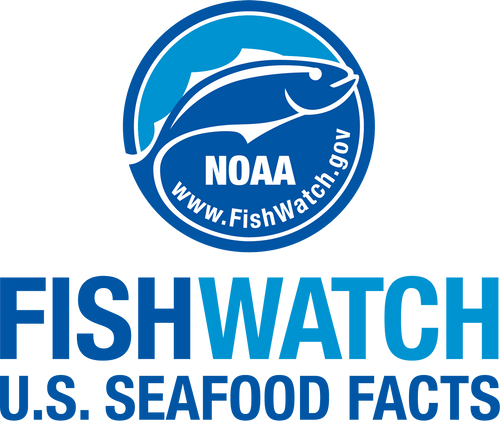 Opah moonfish. Credit: NOAA Fisheries
Opah moonfish. Credit: NOAA Fisheries
Opah moonfish. Credit: NOAA Fisheries
About the Species
 Opah moonfish. Credit: NOAA Fisheries
Opah moonfish. Credit: NOAA Fisheries
Opah moonfish. Credit: NOAA Fisheries
U.S. wild-caught opah is a smart seafood choice because it is sustainably managed and responsibly harvested under U.S. regulations.

Population
The stock has not been assessed. Although the population level is unknown, management measures are in place.

Fishing Rate
Overfishing status is unknown, but management measures are in place.

Habitat Impact
Fishing gear used to catch opah rarely contacts the ocean floor so habitat impacts are minimal.

Bycatch
There is no directed fishery. Regulations are in place to minimize bycatch in the tuna and swordfish fisheries, which incidentally catch opah.
Population Status
- Opah has never been assessed so the population and overfishing status are unknown, but there is no evidence that populations are in decline or that fishing rates are too high.
- Despite the opah's value to commercial and recreational fishermen, little research on the basic biology and ecology of opah has been conducted.
- To begin to fill some of the data gaps, NOAA's Southwest Fisheries Science Center began collecting biological samples from opah in 2009 and initiated an electronic tagging program in 2011.
- Scientists hope to continue tagging opah to learn about their movements and range. This research will provide the basic life history information necessary for future population assessments and management.
Appearance
- Opah are an unusual looking fish—they have a round, flat body that’s silvery gray in color.
- Toward the belly, the silver shades to a rose red, dotted with white spots.
- Their fins and mouth are red, and their large eyes are encircled with gold.
Biology
- Because opah are not a major commercial seafood species and they live in the deep ocean, scientists know very little about their biology and ecology.
- Scientists assume opah share general characteristics with other Pacific Ocean pelagic fish.
- Scientists estimate that opah grow quickly.
- Although they’re not sure of opah’s exact life span, scientists age opah by their fin rays, assuming fin ray marks are formed annually.
- Most opah caught in longline fisheries are estimated to be between 1 and 6 years old.
- They average about 100 pounds with a diameter of 3 feet.
- Opah spawn in warm surface waters throughout the year in the tropics and more seasonally in cooler waters.
- Opah seem to be very productive, potentially spawning many times throughout the spawning season.
- Opah are capable of traveling long distances, often in response to changing oceanic conditions such as temperature.
Where They Live
Range
- Opah are found in tropical and temperate waters around the world.
Habitat
- Opah live in deep open ocean waters.
Fishery Management
- NOAA Fisheries and the Western Pacific Fishery Management Council manage this fishery in the Pacific Islands.
- Managed under the Fishery Ecosystem Plan for the Pelagic Fisheries of the Western Pacific:
- No management measures specifically apply to opah. However, general management measures apply to the fisheries that harvest opah.
- Fishermen are required to have permits and record their catch.
- Gear restrictions and operational requirements to minimize bycatch and potential gear conflicts among different fisheries.
- A limit on the number of permits for Hawaii and American Samoa longline fisheries controls participation in the fishery.
- Longline fishing is prohibited in some areas to protect endangered Hawaiian monk seals, reduce conflicts between fishermen, and prevent localized stock depletion (when a large quantity of fish are removed from an area).
- These zones are enforced through the NOAA Fisheries vessel monitoring system program (longline boats must be equipped with a satellite transponder that provides real-time position updates and tracks vessel movements).
- Hawaii- and American Samoa–based longline vessels must carry onboard observers when requested by NOAA Fisheries, in part to record interactions with sea turtles, seabirds, and marine mammals.
- Annual training in safe handling and release techniques for protected species is required, and all vessels must carry and use specific equipment for handling and releasing these animals.
Harvest
- Commercial fishery:
- In 2021, commercial landings of opah in Hawaii totaled 460,000 pounds and were valued at $1.8 million, according to the NOAA Fisheries commercial fishing landings database.
- While there is no directed fishery for opah, they are harvested in small but significant quantities. U.S. fishermen catch them incidentally in tuna and swordfish fisheries around the U.S. Pacific Islands and off southern California.
- Gear types, habitat impacts, and bycatch:
- In Hawaii, opah are caught using longlines set deep below the surface to target bigeye tuna.
- Off California, they're taken incidentally in the California drift gillnet fishery targeting swordfish.
- Recreational fishery:
- Although not commonly caught, opah are prized by deepwater recreational anglers for their unique colors and light flavor.
Scientific Classification
| Kingdom | Animalia |
|---|---|
| Phylum | Chordata |
| Class | Actinopterygii |
| Order | Lampriformes |
| Family | Lampridae |
| Genus | Lampris |
| Species | guttatus |
Last updated by NOAA Fisheries on 03/21/2025
Featured News
 Chef Tyler Hadfield’s Curried Skate Wings with Tomato-Masala Chutney
Chef Tyler Hadfield’s Curried Skate Wings with Tomato-Masala Chutney
Ring In the New Year With These Crowd-Favorite Seafood Recipes
 Fish and shellfish dishes. Credit: iStock
Fish and shellfish dishes. Credit: iStock
 Chef Rob's Pulled Opah Sandwich. Credit: Sam Wells.
Chef Rob's Pulled Opah Sandwich. Credit: Sam Wells.

Seafood Facts

Is Opah Sustainable?
U.S. wild-caught opah is a smart seafood choice because it is sustainably managed and responsibly harvested under U.S. regulations.
Availability
Year-round, but landings seem to peak from April through August.
Source
U.S. wild-caught from Hawaii, California, and surrounding high seas.
Taste
Opah has a rich, creamy taste. The flavor is distinctive, a cross between tuna and swordfish.
Texture
Firm and fatty with large flakes.
Color
Raw flesh ranges from dark red to orange to pink, and turns white when cooked.
Health Benefits
Opah is a rich source of omega-3s, protein, niacin, vitamins B6 and B12, phosphorus, and selenium. It is also low in sodium.
Nutrition Facts
Servings: 1; Serving Weight: 4 oz. (raw); Calories: 170; Protein: 24 g; Total Fat: 8 g; Total Saturated Fatty Acids: 2.5 g; Carbohydrate: 0 g; Total Sugars: 0 g; Total Dietary Fiber: 0 g; Cholesterol: 60 mg; Selenium: 49 mcg; Sodium: 80 mgOpah Recipes
Opah makes a great substitute in your favorite tuna or swordfish recipe. If you need some cooking inspiration, browse these recipes for opah chili, grilled fish steak, and more!

Last updated by NOAA Fisheries on 03/21/2025
Seafood News
 Fresh-caught taʻape on ice. Credit: Conservation International Hawaiʻi.
Fresh-caught taʻape on ice. Credit: Conservation International Hawaiʻi.
Reducing Waste and Feeding Communities in Hawaiʻi with a Whole Fish Approach
 Chef Tyler Hadfield’s Curried Skate Wings with Tomato-Masala Chutney
Chef Tyler Hadfield’s Curried Skate Wings with Tomato-Masala Chutney
Ring In the New Year With These Crowd-Favorite Seafood Recipes
 NOAA Fisheries, in collaboration with Blue Ocean Mariculture, is conducting a multi-year pilot study to evaluate observational methods and tools for studying Hawaiian monk seal behavior. Courtesy of Blue Ocean Mariculture
NOAA Fisheries, in collaboration with Blue Ocean Mariculture, is conducting a multi-year pilot study to evaluate observational methods and tools for studying Hawaiian monk seal behavior. Courtesy of Blue Ocean Mariculture
AI Meets Aquaculture to Study Hawaiian Monk Seal Interactions With Net Pens
 Tonya Wick aboard a fishing vessel at sea in 1998. Photo courtesy of Tonya Wick
Tonya Wick aboard a fishing vessel at sea in 1998. Photo courtesy of Tonya Wick
Science Overview
NOAA Fisheries conducts various research activities on the biology, behavior, and population health of opah. The results of this research are used to inform management decisions for this species. Opah have not been assessed.
Opah Research in the Eastern Pacific Ocean
Opah are a mid-water pelagic fish that occur seasonally in the Southern California Bight. While they are not targeted, they are taken incidentally in both local recreational fisheries for tuna and the California drift gillnet fishery targeting swordfish.
Despite their value to commercial and recreational fishermen, little research on the basic biology and ecology of opah has been conducted, especially in the Southern California Bight. For example, there are limited data on foraging ecology, size composition in fisheries, essential habitat, and stock structure. Scientists at NOAA’s Southwest Fisheries Science Center have begun to fill some of the data gaps by collecting and analyzing biological samples since 2009 and initiating an electronic tagging program in 2011.
Genetic Analyses of Biological Samples
Genetic analysis has determined that there are multiple species of opah, those caught off California being a different species than those caught off Hawaii. Opah also appear to have a gill arch structure that has never been seen before. The unique structure might help scientists understand their ability to forage deep in the water column, from generally 50 meters at night down to 200 meters during the day. The vertical movements are likely due to opah following prey with similar migrations. Opah primarily forage on squid and deep water fish, such as barracudinas, a small elongated fish of up to 50 centimeters. Barracudinas are notable mid-water predators and they are an important food for large fish, such as tunas, swordfish, bigeye thresher shark and, evidently, opah.
NOAA scientists continue to conduct biological sampling and genetic analysis of opah to further explore intraspecific differences. This includes stomach processing to identify the important prey for opah and whether the diet changes with environmental conditions and dissections of the gills and whole fish to learn about the anatomy of opah and their swimming mechanics.
Tagging Opah
Scientists also hope to continue tagging opah to learn about their movements and range. This research will provide the basic life history information necessary for future population assessments and management. Historical catch data may also show correlations between opah catch and abundance with changes in sea surface conditions such as El Niño and La Niña.
Last updated by NOAA Fisheries on 03/21/2025
Data & Maps
American Samoa Longline Logbook Reports 2023
Logbook summary reports for the 2023 calendar year.
American Samoa Longline Logbook Reports 2022
Logbook summary reports for the 2022 calendar year.
Hawaii and California Longline Logbook Reports 2022
Logbook summary reports for the 2022 calendar year.
Hawaii and California Longline Logbook Reports 2021
Logbook summary reports for the 2021 calendar year.
Research
Coastal Pelagic and Highly Migratory Species Life History Research in the Pacific
We research the reproductive biology, growth, foraging ecology, and distribution of highly migratory and coastal pelagic species in the northeast Pacific Ocean.
Relative Impacts of Simultaneous Stressors on a Pelagic Marine Ecosystem
Model suggests that due to climate change, a decline in the yield of Hawaii's longline fishery may…
Last updated by NOAA Fisheries on 03/21/2025

